Subcutaneous liposomal delivery improves monoclonal antibody pharmacokinetics in vivo
IF 9.4
1区 医学
Q1 ENGINEERING, BIOMEDICAL
引用次数: 0
Abstract
Background Monoclonal antibodies (mAbs) effectively treat and prevent various diseases, but their clinical application is hindered by issues related to the route of administration and pharmacokinetics (PK). Intravenous (IV) administration is cumbersome, while subcutaneous (SC) administration is hampered by lower bioavailability and potential for immunogenicity. This study evaluated the efficacy of liposomal formulations in enhancing the subcutaneous (SC) delivery and PK of broadly neutralizing antibodies (bNAbs) directed against HIV.
Methods: mAbs were encapsulated in liposomes with and without PEGylation. The liposomes were characterized for particle size, polydispersity index, zeta potential, and release. Thereafter, mice were injected with free mAbs or liposome-encapsulated mAbs, and PK was evaluated.
Results: Liposomes exhibited sizes of 85–92 nm with negative surface charges. Encapsulation efficiencies were 61 % for PEGylated and 58 % for non-PEGylated liposomes. Stability testing over 16 weeks revealed that formulations remained stable at 4 °C but showed leakage at 37 C. Cytotoxicity assays confirmed that the liposomal formulations did not affect cell viability or induce apoptosis in HMEC-1 cells. In vivo, PK studies in humanized FcRn mice indicated that the PEGylated formulations generally had higher half-life, Cmax, AUC, and MRT, and lower CL values compared to their non-PEGylated formulations of the same injection type. Both liposomal formulations showed improvements in bioavailability and extended half-life compared to free mAbs administered via SC and IV routes. Compared to the gold standard of IV free mAb injection, SC injection of antibodies encapsulated in PEGylated liposome had up to 80 % higher bioavailability and 45 % extension of half-life. Compared to the SC free mAb injection, the differences were even more pronounced, with liposomal SC injection having up to 113 % higher bioavailability and 81 % extension of half-life.
Conclusion: Overall, liposomal encapsulation effectively protected SC injected mAbs from degradation, facilitated sustained release, and improved PK profiles, suggesting a promising strategy for enhancing the therapeutic potential of mAbs in conditions that need repeated injections. Future work should further optimize liposomal formulations to increase loading capacity, stability, and release kinetics.
Statement of significance
This study addresses a challenge in the administration of monoclonal antibodies (mAbs). Intravenous administration requires additional resources, including nursing staff, making it time-consuming and costly. Although subcutaneous (SC) administration offers a less expensive and more patient-friendly option, it suffers from lower bioavailability and potentially shorter half-life. In this study, we encapsulated mAbs in liposomal formulations specifically designed to enhance their pharmacokinetics by promoting efficient lymphatic transport. Compared with both SC and even IV administration of free antibodies, liposomal formulations of mAbs remarkably improve bioavailability and extend the half-life. This innovative approach combines the comfort of SC administration with enhanced pharmacokinetics, addressing the limitations of current SC delivery methods. Liposomal formulations have the ability to greatly improve SC mAb administration by reducing the amount of antibody needed to be administered, reducing the frequency of injections, and potentially protecting against immunogenicity.

求助全文
约1分钟内获得全文
求助全文
来源期刊

Acta Biomaterialia
工程技术-材料科学:生物材料
CiteScore
16.80
自引率
3.10%
发文量
776
审稿时长
30 days
期刊介绍:
Acta Biomaterialia is a monthly peer-reviewed scientific journal published by Elsevier. The journal was established in January 2005. The editor-in-chief is W.R. Wagner (University of Pittsburgh). The journal covers research in biomaterials science, including the interrelationship of biomaterial structure and function from macroscale to nanoscale. Topical coverage includes biomedical and biocompatible materials.
 求助内容:
求助内容: 应助结果提醒方式:
应助结果提醒方式:


